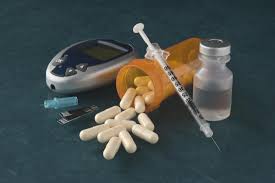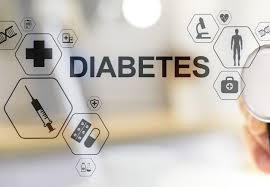
Diabetes can affect almost every part of your body. Therefore, you will need to manage your blood glucose levels, also called blood sugar. Managing your blood glucose, as well as your blood pressure and cholesterol, can help prevent the health problems that can occur when you have diabetes.
Ways to manage your diabetes

- Manage your ABCs
Knowing your diabetes ABCs will help you manage your blood glucose, blood pressure, and cholesterol. Stopping smoking if you smoke will also help you manage your diabetes. Working toward your ABC goals can help lower your chances of having a heart attack, stroke, or other diabetes problems.
A for the A1C test
The A1C test shows your average blood glucose level over the past 3 months. The A1C goal for many people with diabetes is below 7 percent. Ask your health care team what your goal should be.
B for Blood Pressure
The blood pressure goal for most people with diabetes is below 140/90 mm Hg. Ask what your goal should be.
C for Cholesterol
You have two kinds of cholesterol in your blood: LDL and HDL. LDL or “bad” cholesterol can build up and clog your blood vessels. Too much bad cholesterol can cause a heart attack or stroke. HDL or “good” cholesterol helps remove the “bad” cholesterol from your blood vessels.
Ask your health care team what your cholesterol numbers should be. If you are over 40 years of age, you may need to take a statin drug for heart health.
S for Stop Smoking
Not smoking is especially important for people with diabetes because both smoking and diabetes narrow blood vessels. Blood vessel narrowing makes your heart work harder. E-cigarettes aren’t a safe option either.
If you quit smoking
- you will lower your risk for heart attack, stroke, nerve disease, kidney disease, diabetic eye disease, and amputation
- your cholesterol and blood pressure levels may improve
- your blood circulation will improve
- you may have an easier time being physically active
If you smoke or use other tobacco products, stop. Ask for help so you don’t have to do it alone. You can visit SmokeFree.gov for tips on quitting.
- Follow your diabetes meal plan
Make a diabetes meal plan with help from your health care team. Following a meal plan will help you manage your blood glucose, blood pressure, and cholesterol.
Choose fruits and vegetables, beans, whole grains, chicken or turkey without the skin, fish, lean meats, and nonfat or low-fat milk and cheese. Drink water instead of sugar-sweetened beverages. Choose foods that are lower in calories, saturated fat, trans fat, sugar, and salt. Learn more about eating, diet, and nutrition with diabetes.
- Physical activity
Set a goal to be more physically active. Try to work up to 30 minutes or more of physical activity on most days of the week.
Brisk walking and swimming are good ways to move more. If you are not active now, ask your health care team about the types and amounts of physical activity that are right for you. Learn more about being physically active with diabetes.
Following your meal plan and being more active can help you stay at or get to a healthy weight. If you are overweight or obese, work with your health care team to create a weight-loss plan that is right for you.
- Check your blood glucose levels
For many people with diabetes, checking their blood glucose level each day is an important way to manage their diabetes. Monitoring your blood glucose level is most important if you take insulin. The results of blood glucose monitoring can help you make decisions about food, physical activity, and medicines.
The most common way to check your blood glucose level at home is with a blood glucose meter. You get a drop of blood by pricking the side of your fingertip with a lancet. Then you apply the blood to a test strip. The meter will show you how much glucose is in your blood at the moment.
Ask your health care team how often you should check your blood glucose levels. Make sure to keep a record of your blood glucose self-checks. You can print copies of this glucose self-check chart.
- Take your medicine
Take your medicines for diabetes and any other health problems, even when you feel good or have reached your blood glucose, blood pressure, and cholesterol goals. These medicines help you manage your ABCs. Ask your doctor if you need to take aspirin to prevent a heart attack or stroke. Tell your health care professional if you cannot afford your medicines or if you have any side effects from your medicines.
What is continuous glucose monitoring?

Continuous glucose monitoring (CGM) is another way to check your glucose levels. Most CGM systems use a tiny sensor that you insert under your skin. The sensor measures glucose levels in the fluids between your body’s cells every few minutes and can show changes in your glucose level throughout the day and night. If the CGM system shows that your glucose is too high or too low, you should check your glucose with a blood glucose meter before making any changes to your eating plan, physical activity, or medicines. A CGM system is especially useful for people who use insulin and have problems with low blood glucose.
What are the recommended targets for blood glucose levels?

Many people with diabetes aim to keep their blood glucose at these normal levels:
- Before a meal: 80 to 130 mg/dL
- About 2 hours after a meal starts: less than 180 mg/dL
Talk with your health care team about the best target range for you. Be sure to tell your health care professional if your glucose levels often go above or below your target range.
What happens if my blood glucose level becomes too low?

Sometimes blood glucose levels drop below where they should be, which is called hypoglycemia. For most people with diabetes, the blood glucose level is too low when it is below 70 mg/dL.
Hypoglycemia can be life threatening and needs to be treated right away.
What happens if my blood glucose level becomes too high?

Doctors call high blood glucose hyperglycemia.
Symptoms that your blood glucose levels may be too high include
- feeling thirsty
- feeling tired or weak
- headaches
- urinating often
- blurred vision
If you often have high blood glucose levels or symptoms of high blood glucose, talk with your health care team. You may need a change in your diabetes meal plan, physical activity plan, or medicines.
Work with your health care team

Most people with diabetes get health care from a primary care professional. Primary care professionals include internists, family physicians, and pediatricians. Sometimes physician assistants and nurses with extra training, called nurse practitioners, provide primary care. You also will need to see other care professionals from time to time. A team of health care professionals can help you improve your diabetes self-care. Remember, you are the most important member of your health care team.
Besides a primary care professional, your health care team may include
- an endocrinologist for more specialized diabetes care
- a registered dietitian, also called a nutritionist
- a nurse
- a certified diabetes educator
- a pharmacist
- a dentist
- an eye doctor
- a podiatrist, or foot doctor, for foot care
- a social worker, who can help you find financial aid for treatment and community resources
- a counselor or other mental health care professional
When you see members of your health care team, ask questions. Write a list of questions you have before your visit so you don’t forget what you want to ask.
You should see your health care team at least twice a year, and more often if you are having problems or are having trouble reaching your blood glucose, blood pressure, or cholesterol goals. At each visit, be sure you have a blood pressure check, foot check, and weight check; and review your self-care plan. Talk with your health care team about your medicines and whether you need to adjust them. Routine health care will help you find and treat any health problems early, or may be able to help prevent them.
Talk with your doctor about what vaccines you should get External link to keep from getting sick, such as a flu shot and pneumonia shot. Preventing illness is an important part of taking care of your diabetes. Your blood glucose levels are more likely to go up when you’re sick or have an infection.
Cope with your diabetes in healthy ways

Feeling stressed, sad, or angry is common when you live with diabetes. Stress can raise your blood glucose levels, but you can learn ways to lower your stress. Try deep breathing, gardening, taking a walk, doing yoga, meditating, doing a hobby, or listening to your favorite music. Consider taking part in a diabetes education program or support group that teaches you techniques for managing stress. Learn more about healthy ways to cope with stress.
Depression can get in the way of your efforts to manage your diabetes. Ask for help if you feel down. A mental health counselor, support group, clergy member, friend, or family member who will listen to your feelings may help you feel better.
Try to get 7 to 8 hours of sleep each night. Getting enough sleep can help improve your mood and energy level. If you often feel sleepy during the day, you may have obstructive sleep apnea, a condition in which your breathing briefly stops many times during the night. Sleep apnea is common in people who have diabetes. Talk with your health care team if you think you have a sleep problem.
